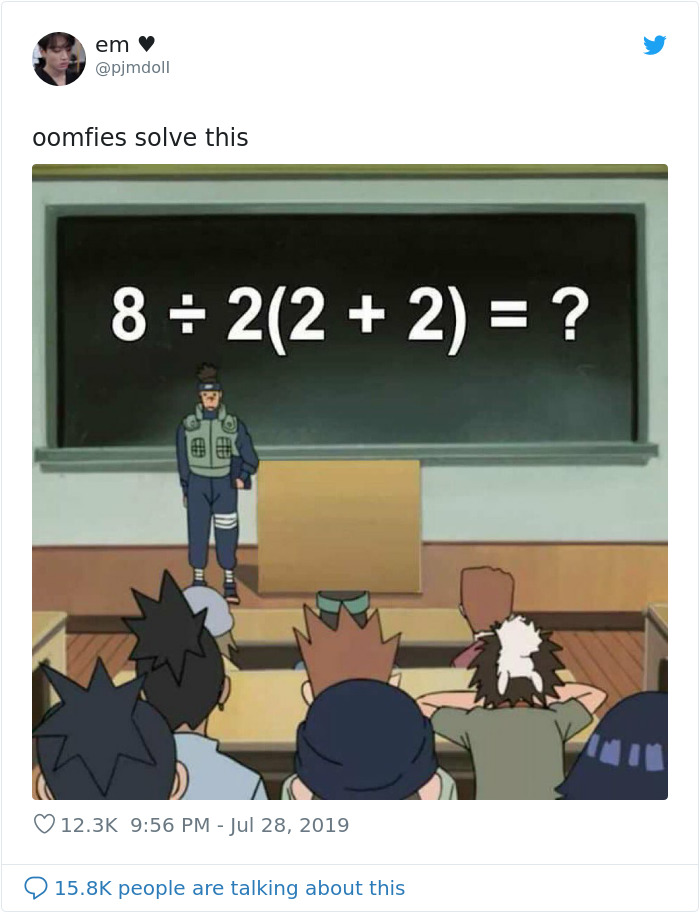
Can You Solve It? Simple Math Equation Goes Viral Since People Can’t Agree On One Answer
When I graduated from university, I thought that was the last time I’d have to do any serious mathematics. Boy, was I wrong. Not only do I still have to help my sisters out with their elementary school maths homework (trust me, it’s surprisingly difficult), but every time I log into Facebook, there’s always some tantalizing equation thrown at me, asking me to solve it.
“Only 1 in 1,000,000 people can solve this simple equation” — we’ve all seen taunts like these, inviting us to dust off our noggins and get our hands dirty with deceptively basic calculations. Well, here’s the newest ‘simple’ equation to go viral on the internet: 8 ÷ 2(2+2) = ? Have you worked out the answer yet? Are you sure? Have you double-checked everything? Did you show your work? Good!
This equation looks simple enough, right? Right?
Image credits: pjmdolI
Image credits: celestiallight_
Image credits: ClassyXhakalaca
Odds are that you got one of two answers: you either belong to the huge swathe of internet users who got 1 or you’re one of the people whose answer is 16. The internet is raging with amateur and professional mathematicians debating what the real answer is. There may have been some arguments over who’s right. And some shouting. Maybe even some shoving.
Some internet users used calculators to show everyone that the answer was 16. Others referred to their ‘maths degrees’ as an appeal of authority to demonstrate that the answer was 1. Others still took this equation business a bit more seriously than you would expect, and suggested that both answers were correct… depending on what rules you use to figure out the answer.
People couldn’t agree whether the answer to the equation was 1 or 16
Image credits: pjmdolI
Image credits: JungKookQueen97
The reason why there’s a lack of consensus regarding this equation is a fairly simple one. Different people are using different rules about what order everything should be calculated in. Whether, after adding 2 and 2 together in the brackets, you should divide 8 by 2 first or multiply what’s in the brackets by 2, instead. This sounds like a basic disagreement, but people got very heated over this.
Image credits: corynhendrix
Image credits: emocowboy410
Robert Glenn Howard, a social psychologist at the University of Wisconsin–Madison, told Slate that such equations are the same as riddles and games, and people get heated over such things because Facebook and other forums are a place for discussion: “People are already primed to engage in pretty intense deliberations, and that can bleed over into the way they play games.”
“Humans have used riddles as a form of play since ancient times,” Howard explained. “And sometimes people can get competitive and wrapped up in it.”
Just in case you were wondering, the answer to the equation is 16. No, wait. Never mind. Yep. Definitely 16. Definitely.
Image credits: lauram_williams
Image credits: lauram_williams
Image credits: skylarrousse
Image credits: questionablmark
Some internet users delved way too deep into the rabbit hole that is Mathematics
Image credits: fcb_banter
Image credits: ceddiascmb
Image credits: supermaddd
Image credits: HumourouslyMe
Image credits: cmcmemes
Image credits: BatmanOfficial_
Image credits: bstpeach
Image credits: bstpeach
Image credits: NomeDaBarbarian
Image credits: jedetestelait
— 🇨🇲🇨 🇲🇪🇲🇪🇸 (@cmcmemes) July 28, 2019
The problem is that some people are taking BODMAS and PEMDAS etc too literally. Even though Bodmas has Division before Multiplication and PEMDAS does the opposite, multiplication and division are EQUAL and therefore go left to right. Ditto addition and subtraction. Using PEMDAS order of operations, therefore, it is Parentheses, then Exponents, then Multiplication and Division, then Addition and Subtraction. There's no controversy here. There's only right and wrong.
@Teri Donovan thank you for explaining why I was wrong. I understand what you mean and it makes sense. Now I’ve learned something new, and upon further analyzing my post, I see where I went wrong.
Load More Replies...The problem is that some people are taking BODMAS and PEMDAS etc too literally. Even though Bodmas has Division before Multiplication and PEMDAS does the opposite, multiplication and division are EQUAL and therefore go left to right. Ditto addition and subtraction. Using PEMDAS order of operations, therefore, it is Parentheses, then Exponents, then Multiplication and Division, then Addition and Subtraction. There's no controversy here. There's only right and wrong.
@Teri Donovan thank you for explaining why I was wrong. I understand what you mean and it makes sense. Now I’ve learned something new, and upon further analyzing my post, I see where I went wrong.
Load More Replies...
 Dark Mode
Dark Mode 

 No fees, cancel anytime
No fees, cancel anytime 







































































164
340